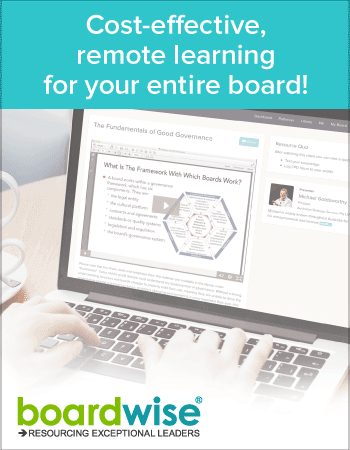Three Essentials of Successful Meetings
-
governance
Governance Three Essentials of Successful Meetings
The number three holds deep significance across cultures and belief systems. Examples abound: the Christian Holy Trinity; the three treasures of Taoism; the three pillars of democracy; the three branches of the U.S. government. This pattern repeats itself endlessly, speaking to an archetypal resonance.
In our everyday lives, too, we find trios everywhere that lend structure, balance, and completion. As the saying goes, “Good things come in threes.”
Meetings are no exception. For a meeting to truly be successful, it must incorporate three key elements:
-
An Agenda laying out discussion topics
-
Meeting Minutes to document proceedings
-
Action Items to drive follow-up
Like the legs of a stool, these three components form a solid foundation. Knock one out, and the whole enterprise teeters. When all three integrate seamlessly, meetings become potent catalysts for progress.
The Agenda - Setting the Stage
The agenda acts as a meeting’s backbone. It dictates the meetings purpose, scope, and desired outcomes.
An effective agenda:
-
Outlines specific discussion topics, goals, and objectives
-
Provides background/context to inform participants
-
Indicates topic sequence and time allotments
-
Defines participant roles and expectations
-
Allows for meeting prep and organisation
The agenda sets expectations about what will transpire. Participants can arrive prepared, with questions, opinions, and materials ready. They understand in advance the intended direction and flow of the meeting.
Without an agenda, meetings tend to meander aimlessly. Important items get shortchanged or forgotten altogether. The discussion grows disjointed and frustrating.
A clear agenda also promotes inclusivity. When the topics and goals are defined upfront, everyone can contribute meaningfully. This avoids situations where a forceful few steer the conversation while others tune out.
Additionally, agendas boost accountability. They remind people of duties to report on progress, lead an analysis, or resolve past action items. Information central to decisions gets shared.
While flexibility has its place, participants should resist the urge to deviation radically from the agenda. Tangents cause meetings to bloat, pushing vital discussions to future gatherings.
Some circumstances warrant more dynamic agendas. Brainstorming or ideation sessions often benefit from freer flow. But even then, the agenda provides helpful guide rails.
Meeting Minutes - Creating a Record
Minutes serve as the official record of what transpires in a meeting. They capture vital details including:
- Date, time, location
- Attendee list
- Agenda topics/order
- Motions proposed and votes taken
- Key discussion points, ideas, and arguments
- Decisions and next steps
Thorough minutes provide continuity across multiple meetings. They refresh memories about past deliberations and decisions. They allow absent members to catch up. Minutes also furnish evidence if disputes arise regarding meeting outcomes.
Many organisations maintain minutes indefinitely as legal and operational archives. Regulatory bodies may audit minutes for compliance purposes. Historical minutes grant insight into an organisation’s evolution.
Minute takers should strive to create minutes with precision and objectivity where subjective interpretations or opinions get omitted. Work to ensure that the facts of the meeting take center stage.
Brevity and a logical structure improve minute quality. The ideal minutes encapsulate only the most salient points and avoid verbatim transcriptions. Bullet points, headings, and concise paragraphs provide visual organisation.
Some board will share a draft of the minutes for all directors to review prior to finalising, some it is only the chair who review the document. Either way, this allows corrections of any errors or omissions.
Technological tools, such as board portals like Our Cat Herder, now enable minute creation and distribution in real-time. Members can reference minutes immediately after meetings, while memories remain fresh. Digital document sharing also facilitates collaborator access.
Action Items - Driving Progress
Any sufficiently productive meeting will generate action items - concrete tasks for participants to complete after adjourning. These categories of action items move the needle:
Information Gathering - Investigate a question, compile relevant data, research existing solutions, survey customers, etc.
Analysis - Interpret findings, run scenarios, assess risks, project costs, identify root causes, etc.
Execution - Take direct action like creating plans, securing resources, making purchases, hiring vendors, building partnerships, marketing, etc.
Accountability - Follow up on outstanding tasks, report back on progress, troubleshoot implementation challenges, request aid in removing roadblocks.
Without action items, meetings become mere theorising. The path from ideas to implementation goes uncharted and momentum often evaporates once the session concludes.
Tracking action items prevents ideas from stagnating and not progressing. Action assignments provide structure and deadlines allowing work continues between meetings, accelerating output and increasing accountability.
For best results, action items should adhere to “SMART” principles:
Specific and Strategic - Target a well-defined, high-impact objective.
Measurable - Quantifiable and verifiable metrics of success.
Achievable- Within the capacity and resources of the assignee.
Relevant - Directly linked to organisation goals and agenda topics.
Time-bound - Calendared deadlines to maintain momentum.
The most successful meetings balance broad strategy with targeted tactics. Big-picture aspirations get translated into concrete, incremental steps, allowing progress and success to compound meeting by meeting.
The Integrated Structure of Agenda, Minutes, Action Items
Agendas, minutes, and action items work symbiotically to optimise meeting outcomes.
The agenda sets the plan, minutes document results, and action items drive implementation. Agendas provide context for minutes, minutes guide action items, and action items inform future meeting agendas.
Each component enhances the others:
-
Well-crafted agendas lead to focused, structured minutes.
-
Thorough minutes clarify and reinforce action items.
-
Completed actions items lend confidence in agendas and minutes.
This interplay continues across a series of meetings. Ongoing iteration helps teams become more disciplined and productive.
Adopting a secure, cloud-based platform enhances this workflow. Features like collaborative agenda creation, minute taking tools, and customisable action tracking make meetings more transparent and engaging. Automation frees boards and the teams that support them to focus on substance rather than busywork logistics.
The “Three-Legged Stool” of Meetings
Like a three-legged stool, meetings rely on the support of agenda, minutes, and action items in order to stand strong. Deficient in any dimension, the meetings (and progress toward strategic goals) wobbles or collapses outright.
But when all three elements integrate seamlessly, meetings become drivers of growth and achievement. They provide structure, documentation, and momentum.
So next time you gather your board or committee remember this timeless principle: the power of three. Build your agenda, record minutes diligently, and relentlessly track actions. Your meetings will reach new heights, and your board and organisation will benefit.
Additional Resources
Free Minute Taking Course: An Introduction for Boards
The Australian Guide to Chairing Meetings — Book Review
Navigating the Annual General Meeting
Why Miscommunication Happens Among Directors
Run a Board Meeting that’s Effective and Productive
Frequently Asked Questions
What makes a meeting successful?
A meeting is successful when it has clear objectives, stays on topic and on schedule, encourages participation from all attendees, resolves issues through constructive discussion, documents next steps and responsibilities, and leaves participants feeling their time was well spent.
What are the 5 Ps of effective meetings?
The 5 Ps framework states effective meetings should have Purpose (clear objectives), Participants (right people and decision makers), Place (physical or virtual location), Papers (documents and materials), and Process (following an agenda, assigning action items, and sharing minutes).
What are the 7 ground rules for effective meetings?
The 7 ground rules for effective meetings are: start and end on time, stick to the agenda, encourage participation, listen respectfully, summarize key points, assign action items, and follow up on open issues.
What are the key features of a good meeting?
Key features of a good meeting include having a clear purpose, advance preparation, active participation, open communication, discussions focused on solutions, meeting management, summarised outcomes, and next steps.
What are the 4 roles for effective meetings?
The 4 key roles for effective meetings are the leader, who sets the agenda and runs the meeting; the gatekeeper, who manages participation; the recorder, who documents minutes; and active participants who share ideas and help make decisions.
What does a successful meeting look like?
A successful meeting will have engaged attendees focused on productive discussions that achieve the intended purpose, yield solutions, assign clear next actions, and conclude by summarising outcomes and appreciating contributions.
What is the 2 question rule for meetings?
The 2 question rule states that any agenda item for a meeting should address two key questions - what needs to be decided and what is the desired outcome?
What is good meeting etiquette?
Good meeting etiquette includes arriving on time, staying focused, turning off devices, listening attentively, participating constructively, allowing others to contribute, avoiding side conversations, and summarising action items.
-



